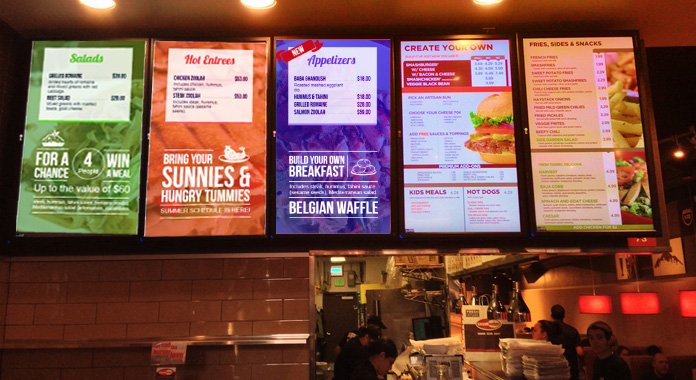The first introduction of digital menu display screens and their application in the dining industry brought fast dynamism. Digital menu display screens are replacing the old printed menus with their digital counterparts, introducing many advantages not only for restaurant owners but also for patrons. As technology continues to infiltrate nearly every facet of our daily lives, it should be no great surprise that the restaurant experience is likewise beginning to undergo a digital revolution.
The Evolution of Restaurant Menus
Conceptually, there has not been much evolutionary change about a restaurant menu over the past several hundred years; more often than not, it has simply been a list of various dishes available for sale. But the digital age brought a new time for screens of dynamically presented menus. Digital menu display screens are now attached to walls and used on tabletop tablets and even handheld devices.
Benefits for Restaurant Owners
1. Cost Efficiency and Flexibility
Among the most considerable advantages of digital menu boards is that they are highly cost-efficient. In the case of traditional menus, they need to be reprinted again and again to enter new prices in the menu, introduce new dishes, or discontinue the existing ones. The process is costly and time-consuming. For digital screens, on the other hand, when a change needs to be made, this can happen with just one touch of a button, updating information instantaneously. This is not only cost-effective in print but also ensures that the menu stays current with its offerings.
2. Enhanced Marketing Opportunities
Digital menus are a great way to market. Through nice bright pictures and videos, one can advertise dishes, which, in a static print menu, is impossible. Additionally, digital screens also allow for the advertisement of special offers, seasonal items, and loyalty programs to further boost sales and customer engagement.
3. Data Analytics and Insights
Another critical benefit is deriving data and insights. This can be done through digital menus that track what is viewed most and least. This data helps restaurant owners make informed decisions on adjusting menus, inventory management, and marketing strategy. Knowing customer preferences and behaviors can allow one to tailor the goods offered to meet greater demand.
Advantages for Customers
1. Enhanced Dining Experience
Digital menu boards offer a decadent dining experience to the customers. High-quality pictures and detailed descriptions of each dish urge the diners to place an order after thinking twice. Some have features that may involve interaction, for example, filtrations on allergen information and pairing suggestions, giving personal touches that increase satisfaction.
2. Faster Service and Reduced Wait Times
Digital menus also boost the speed at which an order is made, reducing the time a customer waits. In some cases, clients can make an order without the involvement of a server directly through the screen. This not only shortens their order time but also reduces the chances of error because orders are sent directly to the kitchen.
3. Accessibility and Convenience
A digital menu is the most accessible tool, especially for customers with accessibility needs. Variable fonts, text-to-speech options, multiple language selections, and others can easily be manifested on digital screens, which lets everyone utilize the options comfortably without any hindrance.
The Environmental Impact
Apart from practical and economic benefits, digital menu display screens have a positive environmental impact. This will go a long way to reduce paper waste on printed menus in restaurants. It goes in line with the current sustainability trends that most food service businesses, as well as consumers, are getting more and more aware of.
Challenges and Considerations
For all the advantages of digital menu board displays, there are some things to watch out for and consider.
1. Initial Investment and Maintenance
The capital cost of digital screens is high for the first time, especially for small establishments. In addition to the physical cost of the screens and their related equipment, the other expenses involve installation, software, and ongoing maintenance. However, many restaurant owners find that the long-term savings and benefits outweigh the initial costs.
2. Technical Issues
A restaurant needs proper technical support to minimize downtime and keep the operation running correctly. Several technical problems impede the whole dining experience, such as system failure and software bugs.
3. Customer Adaptation
While most patrons appreciate the convenience of the menus being digital, a few less-than-initiated patrons need some training or guidance, especially seniors. It is the restaurant’s job to train its staff to help customers get through the menu without frustration and to continue to provide the traditional printed menus for those who don’t like them digitally.
The Future of Digital Menus
The technology is bound to get even more sophisticated over time, and the acceptance of digital menu board displays will increase. Augmented reality and artificial intelligence, along with other technologies, are set to make the dining experience a new domain. For instance, AR could be used to allow customers to see their dishes in 3D before ordering, while AI might come up with personalized suggestions based on previous dining history.
Moreover, integrating the digital menus with other technologies used within the restaurant, such as mobile apps or online ordering systems, would create a better cohesive ecosystem. It will not only cut off operations for the restaurant but also offer a seamless and delightful experience for the customers.
Conclusion
Digital menu display screens are another massive leap for the restaurant industry. These screens continue to reshape our interaction with menus in a much more cost-efficient manner, such as more excellent marketing prospects and helping owners gain great data insights. At the same time, they offer improved accessibility and overall dining experience for customers. As technology grows in sophistication, this potential for change in the dining experience will increase digital menus as a crucial part of modern restaurants.





